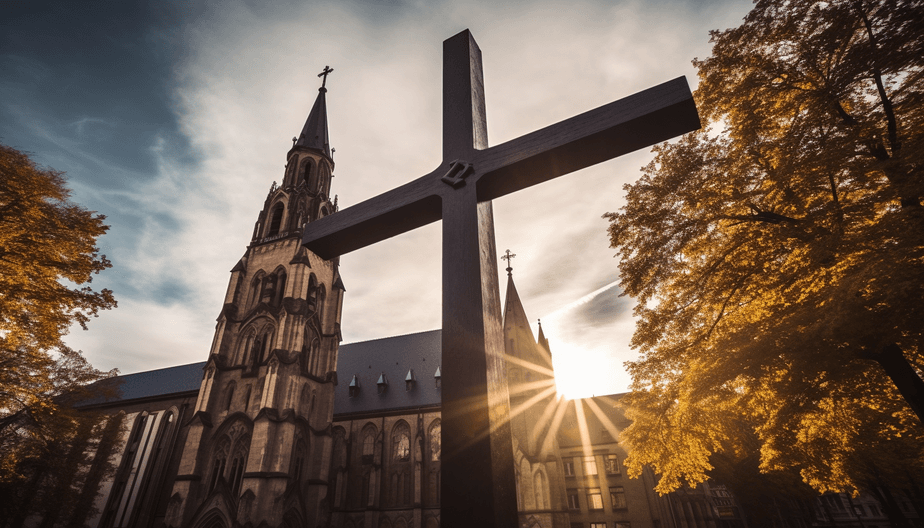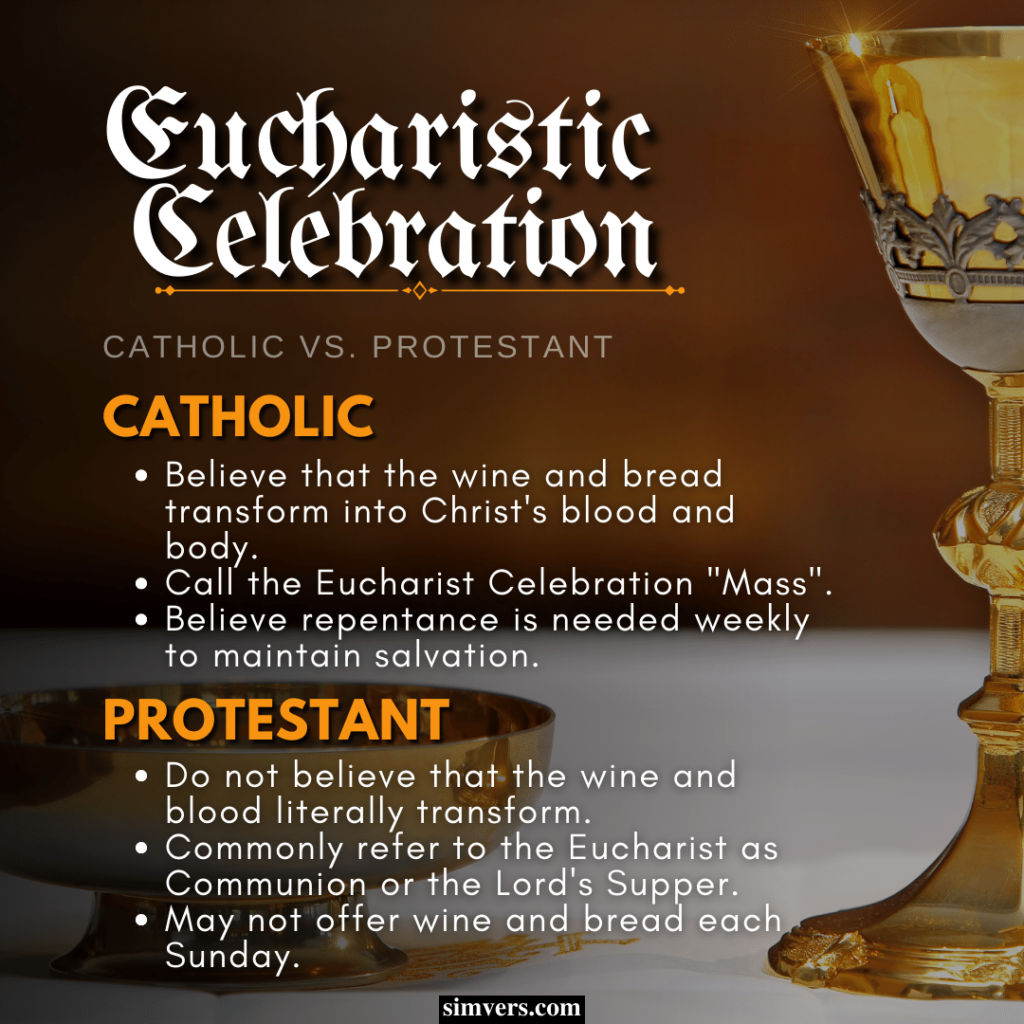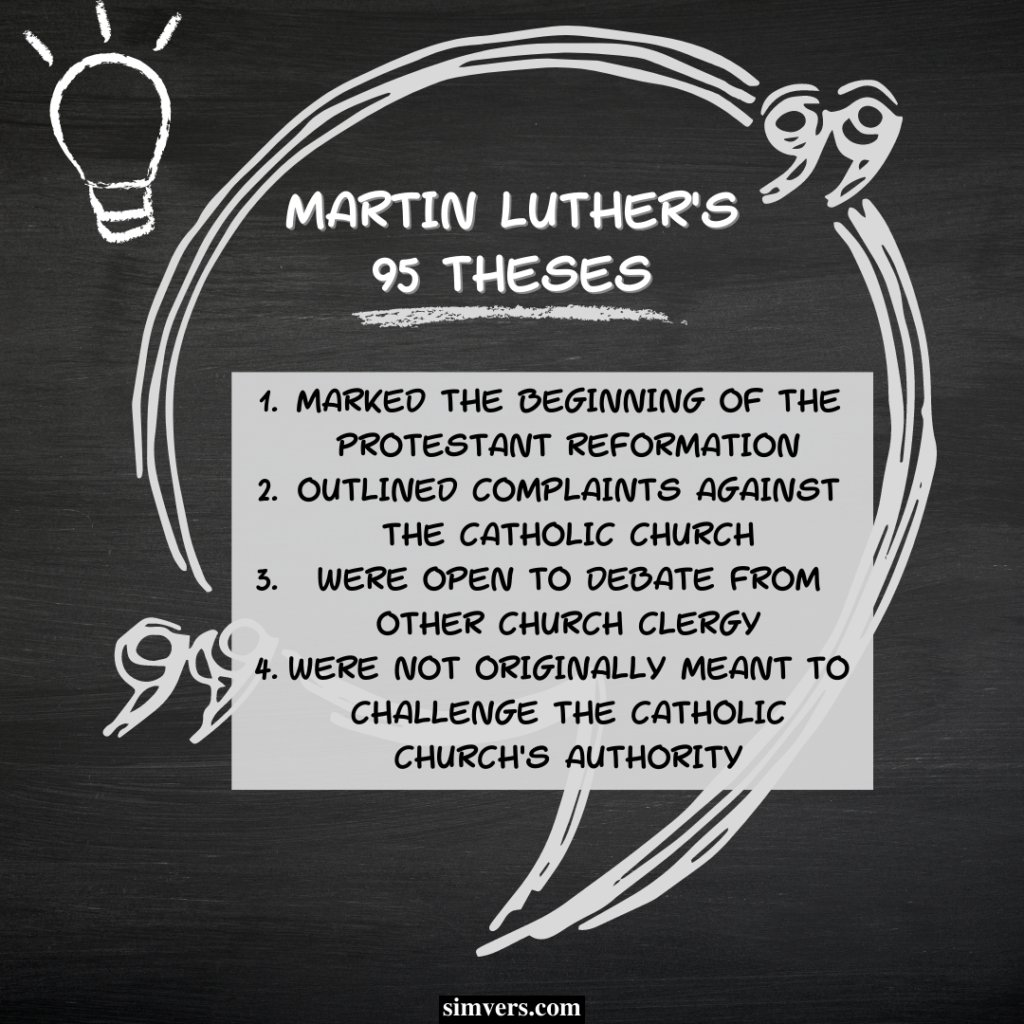
When comparing Catholic vs. Protestant, it’s easy to forget that the two were once just one Catholic Church. While the level of conflict and animosity between the two has lowered over the centuries, the vast differences in their beliefs have not.
The Catholic and Protestant churches hold common foundational beliefs in God but differ in traditions, doctrinal beliefs, and church structure. Protestant churches rejected Catholic ideas and declared their main belief that salvation comes through faith alone during the Protestant Reformation.
Examining the differences between these two world organizations is an eternal task, but you’ll find the key similarities and differences below. As you’ll notice, the divergence of these faiths over time did not stop them from intertwining throughout the centuries. Read on to compare these two faiths and find out what makes each church unique.
Factual & Doctrinal Comparison: Catholic vs. Protestant
Facts
The Catholic church claims its founder was Jesus Christ. Martin Luther founded Protestantism. The headquarters of the Catholic church is in Vatican City, while Protestant churches don’t have a unified headquarters location.
Both churches have the language origins of Hebrew and Greek. Catholicism has additional language origins of Aramaic and Latin. Protestantism has additional language origins in German.
Both churches celebrate Easter and Christmas. However, the Catholic church also celebrates Lent, Pentecost, and Saints’ Feast Days. Some Protestant churches, such as Methodists, celebrate Lent and Pentecost.
Beliefs in Jesus
Both religions believe in the Virgin Birth of Jesus Christ and that he was born of Mary. Both believe Jesus died from crucifixion and that he’ll return to the earth in the Second Coming. Each church believes the original founder of their church is Jesus Christ.
Heaven, Purgatory, and Hell
Purgatory is specific to the Catholic faith. It’s a spiritual place where souls must go through a purification process before entering Heaven. Saints and prayers of faithful members on Earth can help these souls move through Purgatory.
Both Catholics and Protestants believe in Heaven. They believe Heaven is an eternal state where they remain in the divine presence of God, eternally worshipping him. Catholics believe you can get to Heaven through faith and good works, while Protestants believe you can get there by faith alone.
The Catholic church teaches that anyone who freely refuses God will go to Hell, where they will be forever separated from God. Protestants believe the same, but doctrinal differences among specifics of who goes to Hell exist. For instance, Protestant churches have different beliefs on whether people who never heard the gospel are sent to Hell.
Catholics do not believe in predestination. This means that God does not automatically destine people to go to Hell. At the same time, Catholics believe there’s no way of knowing with certainty who will go to Heaven, Hell, or Purgatory.
Holy Scriptures
Both religions use the Holy Bible, consisting of the New and Old Testaments. The Catholic church uses the Douay-Rheims or Knox Versions, while Protestant churches usually use the King James Version. Catholics believe some revelation comes outside scripture, but Protestants believe all revelation from God is already in the Holy Bible.
Catholics have faith in their traditions as well as the scriptures, while Protestants only have faith in the scriptures. During the Protestant Reformation, Martin Luther made it clear that they should only believe in God’s Word. He believed that traditions were unnecessary to the faith.
Deity
Both religions believe in the Holy Trinity, which consists of God the Father, Son, and Holy Spirit. A few Protestant churches believe in the “oneness” of God and reject the notion of the Trinity. As a result, these select churches are not considered to be technically Protestant.
One dogma of the Catholic church is that the Holy Spirit proceeds from the Father and Son. This belief was added to the Nicene Creed in the 300s AD. Catholics believe Jesus Christ is the “Second Person” of the Holy Trinity.
Sacraments
Catholics have seven rites or sacraments. They believe each of these rites was ordained by Jesus Christ. These are baptism, the Eucharist, marriage, penance, confirmation, holy orders, and reconciliation.
Protestant churches only practice two of the seven sacraments. They practice baptism and the Eucharist, which they believe deliver God’s grace and divine word. Protestants accept these sacraments through faith and belief in Christ.
The Pope
Of course, one major difference between the two religions is that Catholics recognize a Pope, and Protestants do not. Catholics believe the Pope traces his priesthood back to Jesus Christ. They believe he succeeds the Apostle Peter, the original head of the Church.
Catholics also recognize this order of succession in other offices of the church. Bishops, priests, and deacons receive the Holy Order sacrament, placing God’s favor on them. On the other hand, Protestants believe this priesthood naturally comes to every believer without requiring Holy Orders.
The Eucharist or The Holy Communion
The Eucharist is also known as the Holy Communion or the Lord’s Supper. It’s a spiritual practice that helps church members honor and remember the Last Supper that Jesus had with his disciples. Catholics believe that the bread and wine of Communion become the body and blood of Jesus after they are blessed.

Non-Catholics cannot accept Communion in the Catholic church since it’s seen as a holy ritual for members only. Protestants allow baptized members to partake of the Holy Communion. They do not believe that the bread and wine of Communion literally become the body and blood of Christ, as Catholics do.
MORE:
- Roman Catholic vs. Lutheran
- Roman Gods & Goddesses
- Bible about Suicide
- Best Order To Read The Bible
- Why Does God Hate Me?
The Virgin Mary and Sainthood
Protestants reject a few Catholic beliefs about Mary. First, they do not accept the idea of her eternal virginity and sainthood. Catholics hold Mary in much higher regard than Protestants, giving her the title of the “Queen of Heaven,” among others.
In the Catholic Church, saints are models of faith to be revered and honored by church members. Catholics can pray to any number of the 4,000 Catholic saints for help and guidance. Further, the Catholic Church honors deceased saints by considering their remains to be holy relics.
Protestants do not pray to saints. In fact, they believe it goes against biblical teachings. Instead, Protestants pray directly to God.
Priests
Both the Catholic Church and the Protestant Church ordain priests who preach scriptural teachings. Catholics believe priests must practice celibacy, meaning they do not get married or have sexual relations their whole lives. Protestants believe that priests are allowed to get married.
In 1520, Martin Luther did away with the Catholic idea of celibacy. Luther went on to get married himself to stand up for this new, more lenient principle. To this day, Catholic priests pledge celibacy.
Women
Generally, Catholic and Protestant churches hold women in lower regard than men. However, some Protestant churches allow women to hold leadership positions. The Catholic Church does not permit women to be ordained as priests or hold positions of authority.
In Catholicism, women can become nuns, devoting their lives to the church’s service. Nuns pledge to a life of poverty, chastity, and obedience to the church. Notably, there are nuns in a few other Christian denominations, such as Lutheranism and Anglicanism.
Salvation
Catholics believe that God grants salvation according to your repentance, good deeds, and faith. In the Catholic church, no one knows who will be saved and who will not. You may lose your salvation if you sin without repenting.
Protestants believe that God grants salvation once you confess Jesus Christ as the Savior and put your faith in him. They do not believe salvation can be removed once you declare your faith in Christ. Generally, they believe that baptism is the outward symbol of an inward transformation of faith.
In Protestantism, this salvation comes through divine grace. They believe God has no reason to forgive and save you, but he does it anyway. This principle is “sola gratia” or “by grace alone.”
Worship
Catholics and Protestants celebrate Sunday as the Lord’s Day. They hold worship services that include singing hymns, reading scripture, and praying or taking communion. You may find that the music is modernized in Protestant church services and makes up a longer portion of the church service.
Catholic Mass, held on Sundays, is the Eucharist celebration. In other words, Mass is their commemoration of the Lord’s Supper when they take the Holy Communion. Every member may drink the wine and eat the bread in honor of Christ.
Not all Protestant faiths administer the Holy Communion every Sunday. Some, like the Methodist church, administer it once per month and simply sing, read, and pray on the other Sundays.
Social Issues
Catholics and Protestants do their best to follow the teaching of Jesus concerning relations with the poor and sick. These churches serve their communities and believe in works of mercy. Both churches feel a calling to help the poor and feed the hungry.
Pope Francis has recently voiced concern for global warming, environmental pollution, and irresponsible consumerism. The Catholic church provides educational and medical services worldwide. In fact, it’s the biggest international charitable organization.
Protestants have also contributed to international medical services and social reform movements. They help educational organizations, found hospitals, and help the elderly and the poor. Protestant demonstrators have shown support for women’s suffrage and prison reforms.
Catholic vs. Protestant Definitions
The term “catholic” derives from a Greek word meaning “universal.” The term “Protestant” comes from the word “protest.” The nature of each belief shines through these literal definitions.
Catholic
The Catholic Church is the largest Christian church worldwide, with about 1.3 billion members. It’s one of the oldest international organizations on Earth. The Catholic church’s massive role in the history of Western civilization cannot be contested.
The Catholic Church is ruled by the Pope and the bishopric, which make up the main governing body of the church. The Church’s main beliefs are in the Nicene Creed. They teach sacred scripture from the Bible, along with ceremonial traditions.
Catholicism has profoundly impacted culture, art, philosophy, and science in the Western world. The Church uses a legal system called canon law to keep order over the leadership and members of its organization.
Protestant
Protestantism is the branch of Christianity that follows the teachings and beliefs of the split church after the Protestant Reformation. The main difference in their belief is that they are justified by God through faith alone, not works. Therefore, they don’t need the blessing of any specifically ordained priest or the Pope.
The first people known as “Protestants” were the six princes of the Roman Empire and fourteen Imperial Free City rulers. These daring individuals began a protest against the Roman Catholic Church. The term protestant was initially political and only applied to Roman Catholic Church dissenters.
Today, the Protestant church is a more general term. It defines the Christians who are not part of the Catholic church. During the Reformation, the term was only used in German politics.
Some Protestant denominations (Lutherans and Calvinists) prefer the term “evangelical” today. In fact, during the Reformation, Martin Luther preferred “evangelical” over “Lutheran.” During the Reformation, “reformational” was another term German politicians used to describe churches that had split from traditional Catholic teachings.
Most Protestants believe in the Nicene Creed, just like Catholics do. Protestants hold the Bible as the highest authority in the church, unlike Catholics. Reformed churches taught the idea of the spiritual presence of Christ during church services and communion.
Historical Differences: Catholic vs. Protestant
Reformation
The Protestant Reformation began in the early 16th century. The separation was one of great conflict, especially in Germany, where the Reformation originated. This conflict lasted for centuries.
The Reformation began when Martin Luther, a Catholic monk, intended to reform the Roman Catholic Church. History reveals that his work to reform the church became much greater. He ended up creating a whole new church.
Luther spread complaints and reformation ideas about the Catholic church. He believed that sins could not be wiped clean using money, as the Catholic church claimed. In Luther’s view, salvation could only be earned through faith alone and nothing else.
Luther nailed an academic evaluation of Catholic issues, called the “Ninety-five Theses,” on the doors of a church in Wittenberg, Germany. He wanted to bring this discussion to the table and improve the church. In this bold document, he openly criticized many aspects of the Catholic church’s system.

The Pope, naturally, swiftly condemned the Reformation efforts. John Calvin, a French theologian and reformer, entered the scene and established an organization in Geneva that led this city to become the new capital of the Reformation. Aided by the newly invented printing press, reformists began spreading the word.
Meanwhile, Protestantism spread from Germany to France. In the 1550s, Protestantism played a large part in politics as high-ranking nobles converted from Catholicism. The Reformation movement also spread into the churches of Switzerland and Scotland, despite heavy persecution.
There were disputes over key doctrines even among the new Protestant churches. Swiss preacher Zwingli infamously met with Martin Luther to resolve heavy doctrinal disputes, but the two men could not compromise.
In the 1530s, King Henry VIII of England rejected the Pope’s jurisdiction after the Pope refused to annul one of his marriages. Therefore, England began its own journey of reformational ideas. The Church of England wrestled with reformed ideas while sympathizing with the long-standing Catholic traditions.
During the following English reigns of Mary I and Elizabeth I, the Church of England was restored more. The Puritan Revolution in England in the 17th century unraveled much of the monarchy’s work to establish laws and doctrine in the new church. Ultimately, this English uprising moved the Church of England more toward Protestantism.
The Church of Scotland underwent its own reformation in the 1560s with similar results. Ultimately, the Church of Scotland rejected the Pope’s authority and instated a new set of Protestant rules. During the Reformation, many other countries followed in these footsteps.
Most Protestant churches during this era were members of the Lutheran Church, which has noticeable differences compared to the Roman Catholic Church. The second most popular Protestant church was the Calvinist church, followed by the Anglicans and Hussites. The peak of the Reformation occurred between 1545 and 1620.
Post-Reformation
The Protestant church in Europe received sweeping waves of further restoration and rejuvenation during the First Great Awakening during the 1730s and 1740s. American Protestantism was particularly impacted during these years, and Protestant churches became popular. The main idea spread during the First Great Awakening was that religion could be deeply personal, and all you needed was a personal faith in Jesus Christ.
The Second Great Awakening in the 1790s also increased the number of Protestant church members. Specifically, the Baptist and Methodist churches saw large membership increases. The Second Great Awakening lasted through the 1840s.
The Third Great Awakening, specific to America, ranged from the 1850s to the 1900s. This Awakening affected Protestant denominations and added social activism to church ideals. Reformers during this time period believed that the Second Coming of Christ would happen after the entire world was reformed.
Catholic Church History
In the 1st century AD, the foundations of the Catholic church were laid by the teachings of Jesus Christ before his crucifixion. The Catholic Church teaches that its doctrine and traditions draw directly from this time period in the Judean province of the Roman Empire. Although pagans in the Roman Empire fought back against the new Christian religion, the church prevailed throughout the Roman Empire.
Constantine legalized Christianity in the Roman Empire in 313 and declared it the state religion in 380. In the 11th century, the church split between Catholic and Orthodox churches following the conflict. At that time, some Eastern churches remained in communion with the Catholic church and later became Eastern Catholic churches.
From the 5th century onward, the Catholic church became the predominant influencer of Western culture. The church influenced Renaissance ideas and artwork. Of course, in the 16th century, the Catholic church’s stronghold on Europe began to weaken with the coming of the Protestant Reformation.
At the same time, Catholic Spanish and Portuguese conquistadors spread their religion in the Americas, Africa, and Asia. Centuries later, in the 20th century, some world governments, such as Mexico and Spain, persecuted clerics of the Catholic church.
In the 1960s, Catholic authority established more reformations to modernize the church, much to the discomfort of traditional Catholics. Despite criticism, the Catholic church still does not allow women to be priests, remarriage after divorce, same-sex marriage, abortion, or birth control. In the interest of tradition, the church remains firm on these controversial issues.
Conclusion
Some believe the doctrinal and traditional differences between the Catholic and Protestant churches are inconsequential. They prefer to take a wide stance on the nature of God and the meaning of the Christian Church. Indeed, many spiritual people today would rather believe in the idea of God and all the positive teachings of the Bible than be weighed down by arguments about specific beliefs.
While it may be easier to ignore religious differences among Christians today, there’s no question that they’ve historically impacted the world. The level of conflict that has occurred because of these differences in belief is devastating. All that’s left to do is to study and analyze these differences while hoping for a better tomorrow.
The most important thing for any believer is to wholly understand their faith’s basis, history, and implications and how it relates to other beliefs and the world around them. Understanding the fascinating history of Catholics and Protestants will surely increase the spiritual growth of church members.
MORE:
- Jesus’ Birth
- Is Jesus God
- Non-denominational Churches
- Norse Gods and Goddesses
- Old Testament vs New Testament
